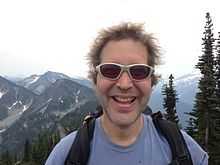David Baker (biochemist)
| David Baker | |
|---|---|
 David Baker at the summit of Spark Plug Mountain, Washington, July 31, 2013 | |
| Born | October 6, 1962 |
| Fields | computational biologist |
| Institutions | University of Washington, Howard Hughes Medical Institute |
| Alma mater | University of California, Berkeley, University of California, San Francisco |
| Doctoral advisor | Randy Schekman |
| Other academic advisors | David Agard |
| Known for | Protein structure prediction, Rosetta@Home, Fold.it |
| Notable awards | Overton Prize |
| Website | |
| www.bakerlab.org | |
David Baker (born October 6, 1962 in Seattle, Washington[citation needed]) is an American biochemist and computational biologist who studies methods to predict the three-dimensional structures of proteins. He is a Professor of Biochemistry at the University of Washington (UW),[1] where he is the principal investigator of the 60+ member Baker laboratory. He is a Howard Hughes Medical Institute investigator, and is also a member of the United States National Academy of Sciences.
Life
The Baker laboratory developed the Rosetta algorithm for ab initio protein structure prediction, which has been extended to a distributed computing project called Rosetta@Home[2] and Foldit.[3][4] The project aims to produce structural models for protein complexes as well as individual polypeptide chains. The Baker group participates regularly and is recognized for expertise in the CASP structure prediction experiment using ab initio methods, including both manually assisted and automated variants of the Rosetta protocol.
Members of the Baker group are also active in the field of protein design; they are recognized as the first group to have designed a protein, known as Top7, with an entirely novel fold.[citation needed]
Baker did his graduate work in biochemistry at the University of California, Berkeley in the laboratory of Randy Schekman, where he worked predominantly on protein transport and trafficking in yeast. He did his postdoctoral work with David Agard of University of California, San Francisco.
Although well known for development of methods for computational prediction of protein structure and function, Baker is focused on the use of computational methods to drive experimental assessment of biology and therefore the Baker laboratory maintains an active experimental biochemistry group.
For his work on protein folding, Baker received the 2008 Sackler International Prize in Biophysics.[5] Baker was elected a Fellow of the American Academy of Arts and Sciences in 2009.[6] He is married to Hannele Ruohola-Baker, another biochemist at UW. They have two children, Benjamin and Amanda, both of whom are currently attending Garfield High School in Seattle.
Publications
Computational work
- Vincent, J. J.; Tai, C. H.; Sathyanarayana, B. K.; Lee, B. (2005). "Assessment of CASP6 predictions for new and nearly new fold targets". Proteins: Structure, Function, and Bioinformatics 61: 67–83. doi:10.1002/prot.20722. PMID 16187347.
- Bradley, P.; Malmström, L.; Qian, B.; Schonbrun, J.; Chivian, D.; Kim, D. E.; Meiler, J.; Misura, K. M. S.; Baker, D. (2005). "Free modeling with Rosetta in CASP6". Proteins: Structure, Function, and Bioinformatics 61: 128–134. doi:10.1002/prot.20729. PMID 16187354.
- Kuhlman, B.; Dantas, G.; Ireton, G.; Varani, G.; Stoddard, B.; Baker, D. (2003). "Design of a novel globular protein fold with atomic-level accuracy". Science 302 (5649): 1364–1368. Bibcode:2003Sci...302.1364K. doi:10.1126/science.1089427. PMID 14631033.
- Gray, J.; Moughon, S.; Wang, C.; Schueler-Furman, O.; Kuhlman, B.; Rohl, C.; Baker, D. (2003). "Protein-protein docking with simultaneous optimization of rigid-body displacement and side-chain conformations". Journal of Molecular Biology 331 (1): 281–299. doi:10.1016/S0022-2836(03)00670-3. PMID 12875852.
- Bonneau, R.; Tsai, J.; Ruczinski, I.; Chivian, D.; Rohl, C.; Strauss, C. E. M.; Baker, D. (2001). "Rosetta in CASP4: Progress in ab initio protein structure prediction". Proteins: Structure, Function, and Genetics 45: 119–126. doi:10.1002/prot.1170. PMID 11835488.
- ROBETTA prediction server
Yeast work
- Baker, D.; Hicke, L.; Rexach, M.; Schleyer, M.; Schekman, R. (1988). "Reconstitution of SEC gene product-dependent intercompartmental protein transport". Cell 54 (3): 335–344. doi:10.1016/0092-8674(88)90196-1. PMID 3293799.
- Baker, D.; Wuestehube, L.; Schekman, R.; Botstein, D.; Segev, N. (1990). "GTP-binding Ypt1 protein and Ca2+ function independently in a cell-free protein transport reaction". Proceedings of the National Academy of Sciences of the United States of America 87 (1): 355–359. Bibcode:1990PNAS...87..355B. doi:10.1073/pnas.87.1.355. PMC 53262. PMID 2104983.
References
- ↑ http://www.bakerlab.org Baker laboratory website
- ↑ http://boinc.bakerlab.org/rosetta/ Rosetta@home project homepage
- ↑ Hand, E. (2010). "Citizen science: People power". Nature 466 (7307): 685–687. doi:10.1038/466685a. PMID 20686547.
- ↑ Cooper, S.; Khatib, F.; Treuille, A.; Barbero, J.; Lee, J.; Beenen, M.; Leaver-Fay, A.; Baker, D.; Popović, Z.; Players, F. (2010). "Predicting protein structures with a multiplayer online game". Nature 466 (7307): 756–760. Bibcode:2010Natur.466..756C. doi:10.1038/nature09304. PMC 2956414. PMID 20686574.
- ↑ Leila Gray (November 24, 2008). "University of Washington biochemist David Baker to receive 2008 Sackler International Prize in Biophysics for discoveries in protein folding". University of Washington. Retrieved April 29, 2013.
- ↑ "Book of Members, 1780-2010: Chapter B". American Academy of Arts and Sciences. Retrieved 5 May 2011.